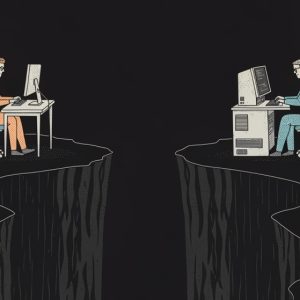
The earth’s resources are finite. Since the turn of the millennium, the world has been using its natural resources at an alarming rate. The global material footprint rose from 54 billion tonnes in 2000, to 92 billion in 2017, an increase of 70%. As world leaders to the “Build Back Better Agenda” following COP26, there remains a distinct lack of discussion around natural resource protection – which provides the backbone to the very meaning of the word sustainability.
Operating with the possibility of producing ‘waste’ is irresponsible and industries need to learn to manage the global raw materials and rare earth minerals we have before the supplies soon dry up. Indeed, our very definition of the word “waste” is problematic at its core.

The technology industry produces 57m tonnes of ‘waste’ every year – heavier than the Great Wall of China. (Photo by Adam Smigielski / iStock)
Challenging the definition of ‘waste’
The act of ‘wasting’ something is defined as “using something in a careless or unnecessary way, causing it to be lost or destroyed”. If the very definition of waste refers to acting carelessly and unnecessary, then we really need to change how we approach the subject.
As the importance of reuse starts gaining momentum both in the media and business agendas, the need to preserve resources and minimise careless and unnecessary waste has never been greater.
Ultimately our approach to manufacturing new products and materials must begin to change with this movement, and it’s through innovation and disruptive technologies that we can begin this transition. So, whilst the definition of waste has previously discarded the value left in materials beyond their initial lifespan, we must now use the value in all material assets and look beyond the commercially outlined lifespan to pave way for the redistribution of resources.
Technology’s e-waste burden
Singling out the technology industry as a focus point, its current model of ‘take, make and replace’ has created a mountain of electronic waste, 57 million tonnes a year in fact, heavier than the Great Wall of China. As the fastest-growing waste stream in the world, it’s clear action needs to be taken.
Yet the reality is, old tech produchttps://protect-eu.mimecast.com/s/OJMoCXMZktXDVXnIk7HMe?domain=statista.comts are not ‘waste’. The value in each old piece of tech is tremendous, packed with valuable natural resources and incredibly useful to future production. With supply chain crises around the world, such as the global chip shortage, the abundance of old dormant technology plays a vital role in not only meeting demand but preserving them from becoming waste.
One of the ripple effects of the pandemic, and the shift towards working from home is the unprecedented rise in demand for enterprise-level equipment. This, coupled with Brexit trade complexities, has meant that supply shortages are visibly impacting businesses. So as the world moves towards this hybrid working system, global IT procurement must keep up with the times, and a simple way of meeting demand is by utilising dormant tech.
Only 17.4% of global e-waste is collected and properly recycled but that alone amounts to $10 billion in raw material value.
Only 17.4% of global e-waste is collected and properly recycled but that alone amounts to $10bn in raw material value. With an estimated total value of $57 billion for raw materials within global e-waste, the technology industry is sitting on a circular economy goldmine.
The challenge now lies in firstly changing perceptions about second-hand technology. From that of a hand-me-down, to materials that have simply come to the end of its original useful life to its current owner. But also the need to ensure second life products go beyond a simple refurbishment or repair to ensure they have a fully extended second use and minimise their overall environmental impact.
Remanufacturing and reuse
There are now genuine alternatives to both the term ‘waste’ as well as to ‘new’ which are pushing the boundaries of traditional processes and challenging the discourse around second-hand devices. Remanufacturing is the process of providing a second life to a product by placing it back through the manufacturing process to bring performance levels back to its original standard.
Most recently, our Circular Remanufacturing Process achieved the first of its kind in the IT industry, receiving a British Standard ISO 8887-211classification which marked a massive shift in perception of second-hand devices and a new era of opportunity. This disruptive process goes beyond repairs and provides a viable alternative to new, helping the technology industry create a circular economy where old products are saved from becoming waste.
With the rise of the chief sustainability officer taking a more prominent role in the c-suite, processes such as remanufacturing are now being prioritised to help decarbonise business estates and help meet net zero targets. It’s an exciting time for the industry at large, with Apple committing to repairing old products without charge, to Samsung declaring they are building in sustainability to everything they produce; the technology industry is now primely placed to be a leader in the circular economy.
Creating an alternative to waste
The reality is, if we want to challenge the negative and dormant connotations associated with the term “waste” altogether then there needs to be an alternative way of viewing materials and products that are beyond their initial lifecycle. As we reframe how we look at waste with the aim of closing the production loop, we can begin to eradicate waste from the dictionary altogether. Our experts at Circular Computing have suggested replacing the term ‘waste’ with ‘next-generation resources’.
If the natural resources are in their first life, then next-generation resources are those that have been given a second lease of life, and a third, and a fourth and so on. When such materials have then gone beyond their valuable use, they can be recycled or disposed of in a fit and proper way, not carelessly thrown away. In doing so, we create a viable circular economy where waste is but a fever dream, and the earth’s precious natural resources are preserved for generations to come.
Removing the possibility of waste will not only be good for our planet, but for business growth and innovation, with the opportunity for business leaders to now take an active and less passive role in leading this charge instead of waiting for government targets to dictate their sustainability journey.






